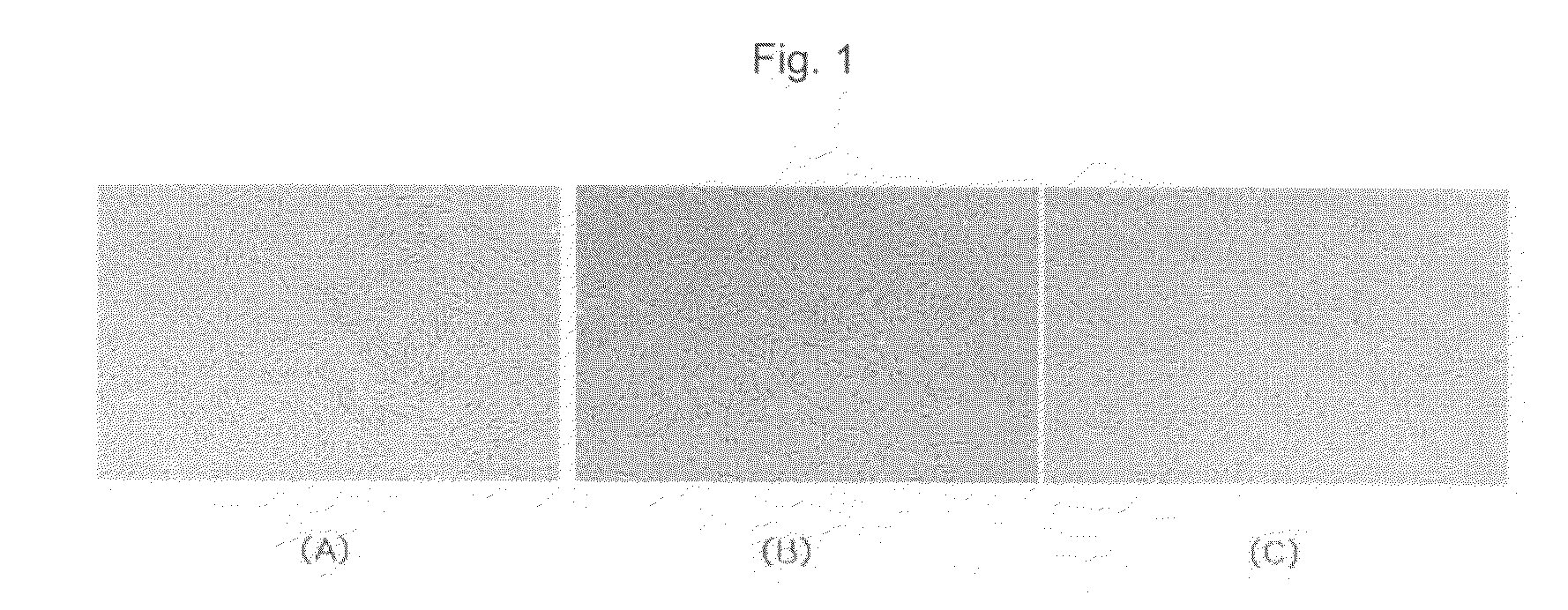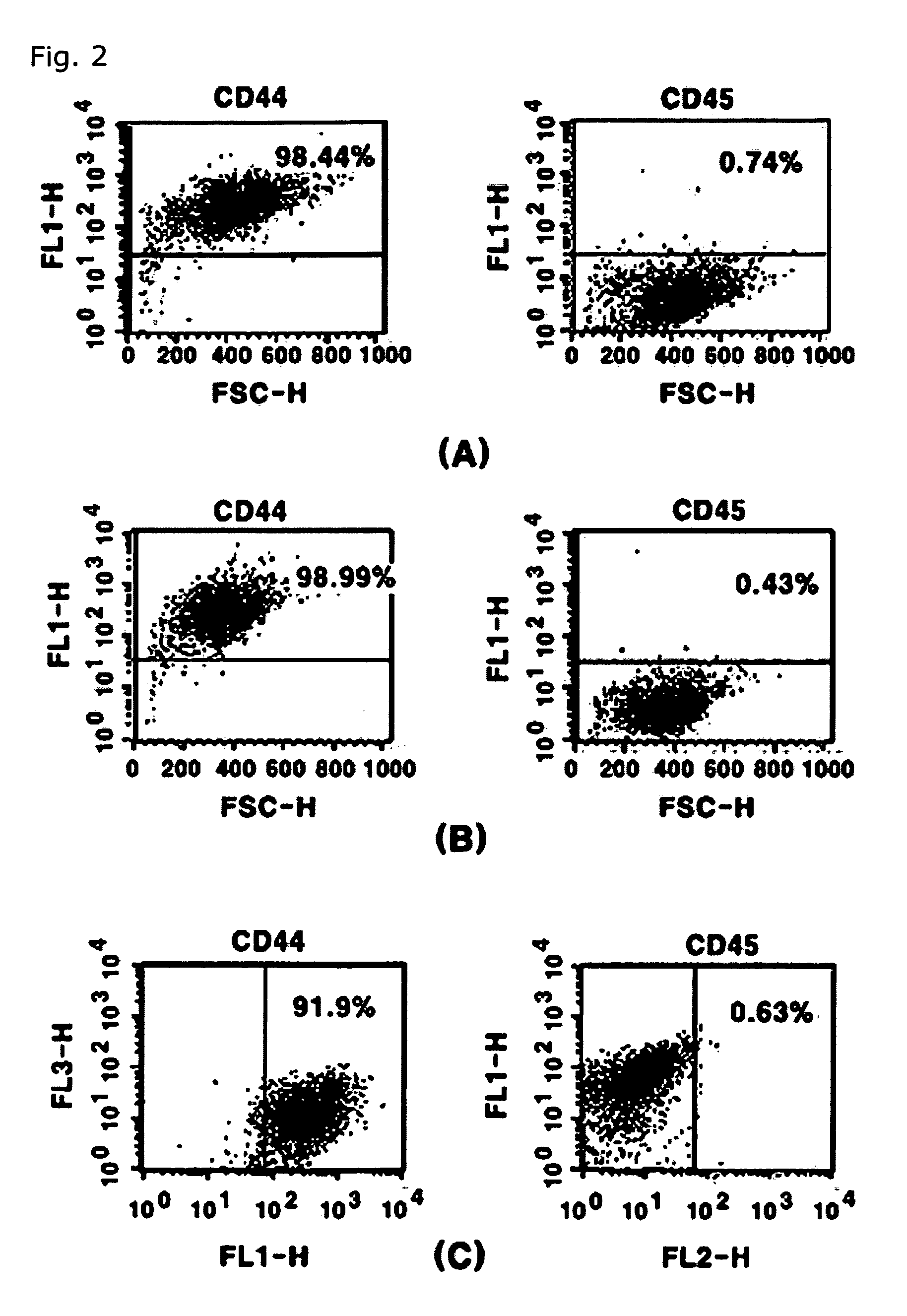Neuronal differentiation method of adult stem cells using small molecules
a stem cell and neuronal differentiation technology, applied in the direction of skeletal/connective tissue cells, drug compositions, biocide, etc., can solve the problems of increasing social and economic costs due to increased degenerative neuronal diseases, no effective method has been known to treat the disorder before, and the damage caused by industrial disasters and traffic accidents is on the increas
- Summary
- Abstract
- Description
- Claims
- Application Information
AI Technical Summary
Benefits of technology
Problems solved by technology
Method used
Image
Examples
example 1
Isolation and Culturing of Adult Stem Cells
[0045]This example illustrates isolation and culturing of stem cells derived from bone marrow, muscles and adipose tissues as cell source for differentiation into nerve cells.
[0046]Stage 1: Isolation of Stem Cells
[0047]Bone marrow-derived mesenchymal stem cells were isolated as first cell source.
[0048]Phosphate buffered saline (Gibco Life Technology, Germany) was perfused into the femur, the fibula and the tibia of Fischer rats weighing 60 to 80 g using a 1 mL syringe. Cells were taken from the hollow interior of the bones and isolated through centrifuge. The cells were cultured using DMEM (Dulbecco's modified Eagle medium; Gibco Life Technology, Germany) containing 10% FBS and 1% antibiotics.
[0049]Muscle-derived stem cells were isolated as second cell source.
[0050]Skeletal muscle was separated from the femoral region of Fischer rats weighing 60 to 80 g, and cells were isolated using collagenase, trypsin and dispase. The isolated cells were...
example 2
Differentiation of Stem Cells into Nerve Cells Using Small Molecules
[0058]In this example, differentiation of the adult stem cells isolated in Example 1 into nerve cells was induced.
[0059]Bone marrow-derived mesenchymal stem cells subcultured for 5 generations were distributed on a well plate. One day later, the cells were treated with DMEM containing 20% FBS and 10 ng / mL b-FGF for a day, so that the cells could proliferate sufficiently. In order to induce differentiation into nerve cells, the cells were treated with differentiation medium containing the small molecules listed in Table 1. The small molecules were used after being dissolved in DMSO (Sigma, USA). The concentration of DMSO was less than 2% of the entire culture medium, and was diluted so that the small molecules were included with a concentration in the range from 1 μM to 100 μM. As negative control, DMEM containing 10% FBS and 1% penicillin-streptomycin was used. And, retinoic acid as positive control, which is a well...
example 3
Evaluation of Toxicity of Small Molecules to Stem Cells
[0061]In this example, the toxicity of the small molecules to the stem cells during the differentiation of the adult stem cells into nerve cells in Example 2 was evaluated.
[0062]MTT assay is a technique based on the principle that yellow, water-soluble MTT tetrazolium is reduced to purple, water-insoluble MTT formazan by the action of mitochondrial dehydrogenase. The formazan concentration is indicative of the concentration of living and actively metabolizing cells. For MTT assay, bone marrow- and muscle-derived stem cells were distributed to a 24-well plate, at a concentration of 3×104 cells / well, and cultured in an incubator for a day. After treating with culture medium, as in the procedure of inducement of differentiation into nerve cells in Example 2, the culture medium was replaced by 1 mL of new culture medium on day 1 and day 4.
[0063]First, cell toxicity was evaluated at concentrations of 2 μM, 10 μM and 100 μM [FIG. 5]. ...
PUM
| Property | Measurement | Unit |
|---|---|---|
| concentration | aaaaa | aaaaa |
| rigidity | aaaaa | aaaaa |
| plasticity | aaaaa | aaaaa |
Abstract
Description
Claims
Application Information
 Login to View More
Login to View More - R&D
- Intellectual Property
- Life Sciences
- Materials
- Tech Scout
- Unparalleled Data Quality
- Higher Quality Content
- 60% Fewer Hallucinations
Browse by: Latest US Patents, China's latest patents, Technical Efficacy Thesaurus, Application Domain, Technology Topic, Popular Technical Reports.
© 2025 PatSnap. All rights reserved.Legal|Privacy policy|Modern Slavery Act Transparency Statement|Sitemap|About US| Contact US: help@patsnap.com



